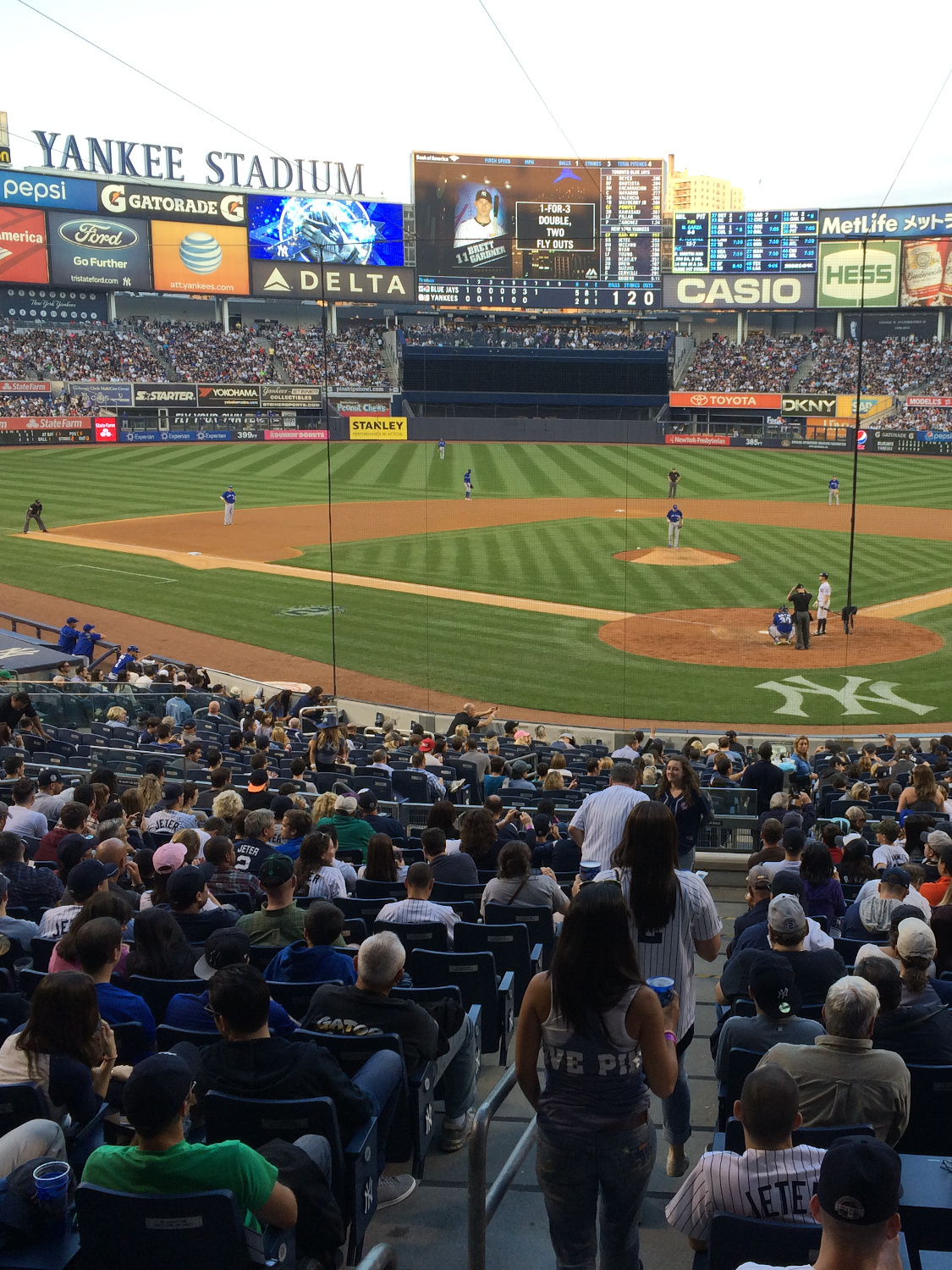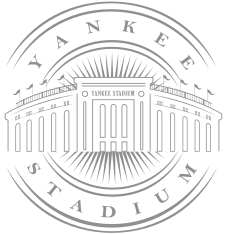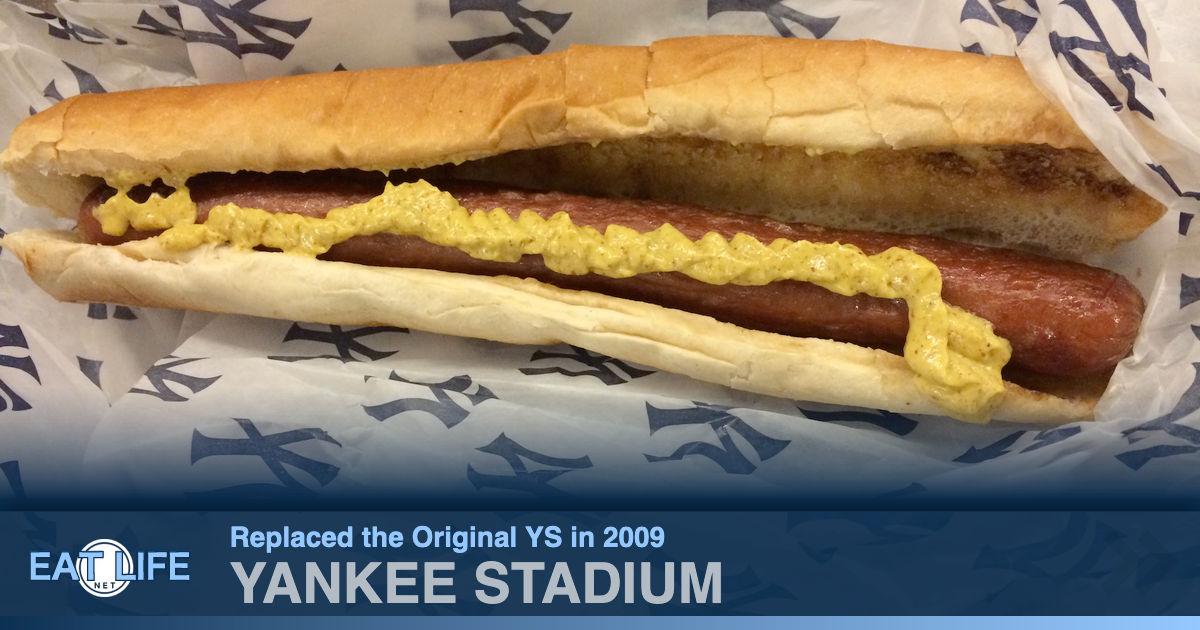Yankee Stadium is a baseball park located in Concourse, Bronx, New York CityYankee Stadium:
- The home field for the New York Yankees of Major League Baseball
- It replaced the original Yankee Stadium in 2009
- It is the sixth-largest stadium in MLB by seating capacity
- It is located one block north of the original
- The stadium incorporates replicas of some design elements from the original Yankee Stadium
- The $1.5 billion price tag makes the new Yankee Stadium one of the most expensive stadiums ever built.
During construction of the new stadium, a construction worker and avid Boston Red Sox fan buried a replica jersey of Red Sox player David Ortiz underneath the visitors' dugout with the objective of placing a hex on the Yankees. After the worker was exposed by co-workers, he was forced to help exhume the jersey. The Yankees organization then donated the retrieved jersey. The worker has since claimed to have buried a 2004 American League Championship Series program/scorecard, but has not said where he placed it. These attempts didn't have much effect upon the Yankees though: they went on to win the 2009 World Series at the end of their first MLB season in the new stadium.
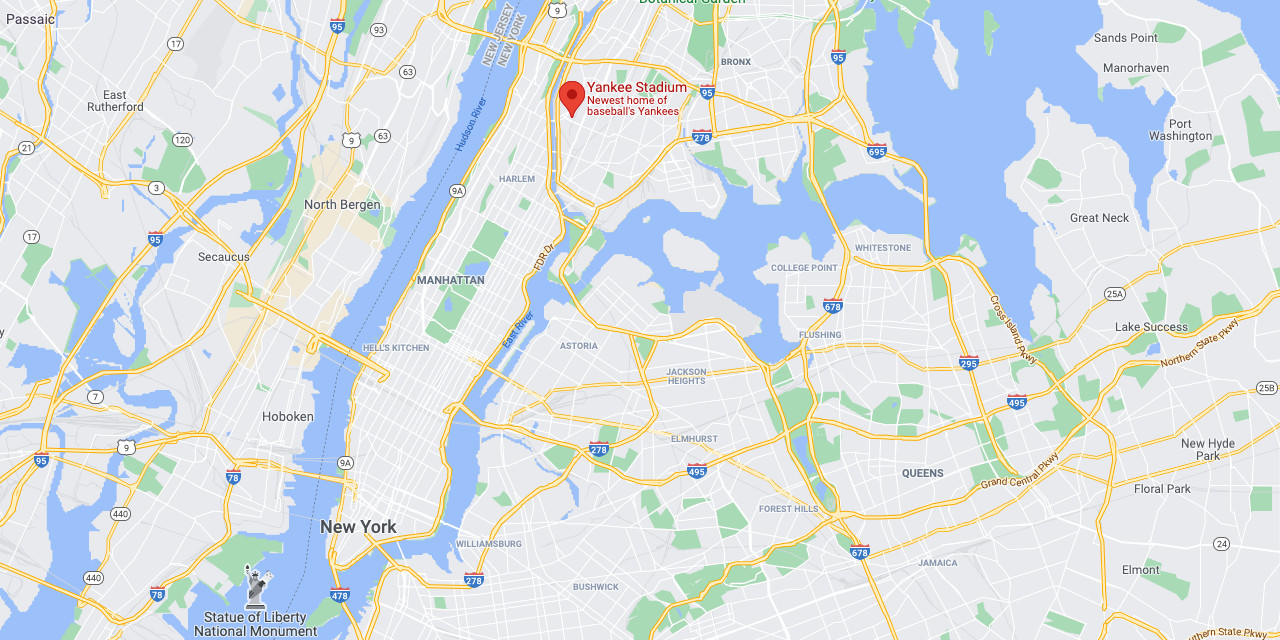
https://www.google.com/maps/place/Yankee+Stadium
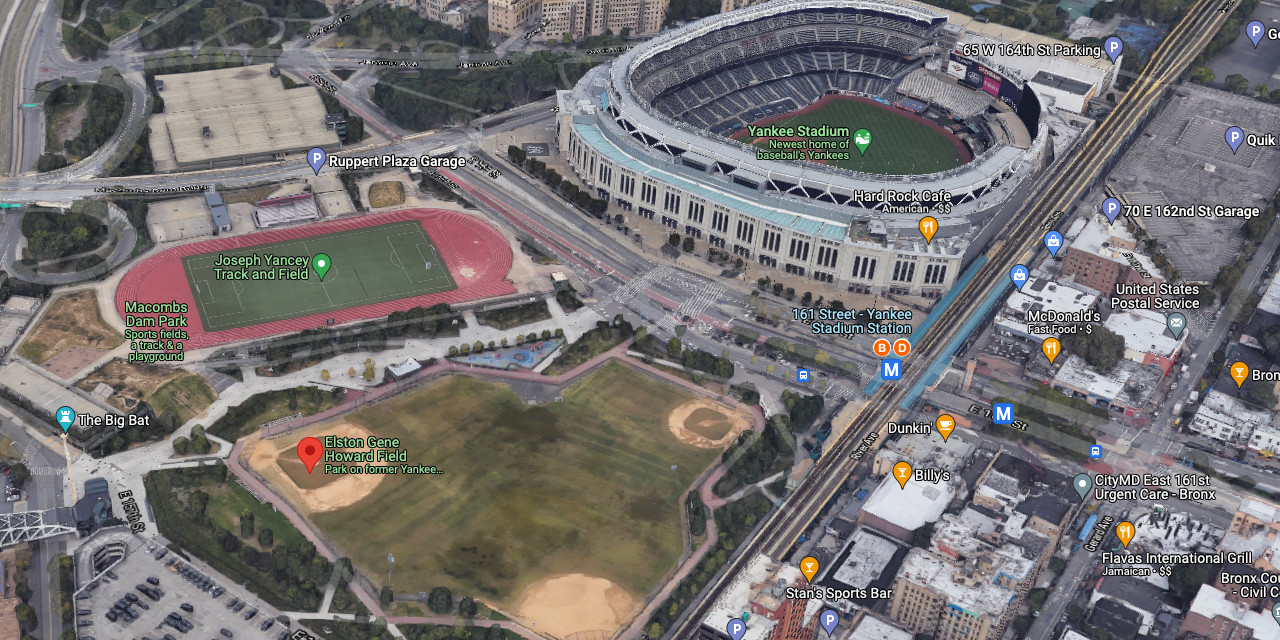
Across the street is the site of the original Yankee Stadium. It's a park called Elston Gene Howard Field. You can walk on the same field that Babe Ruth played on!
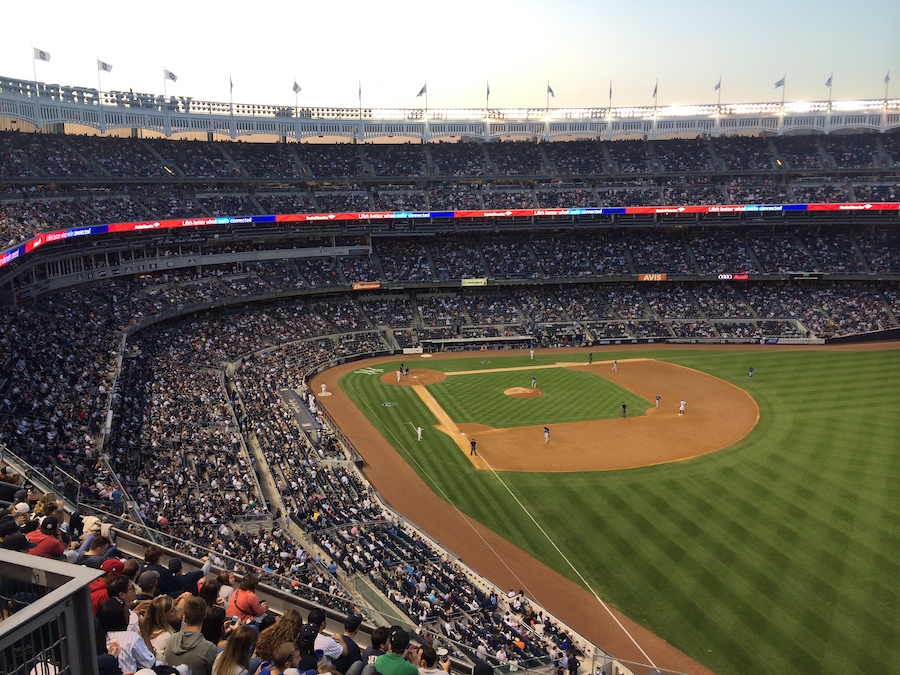
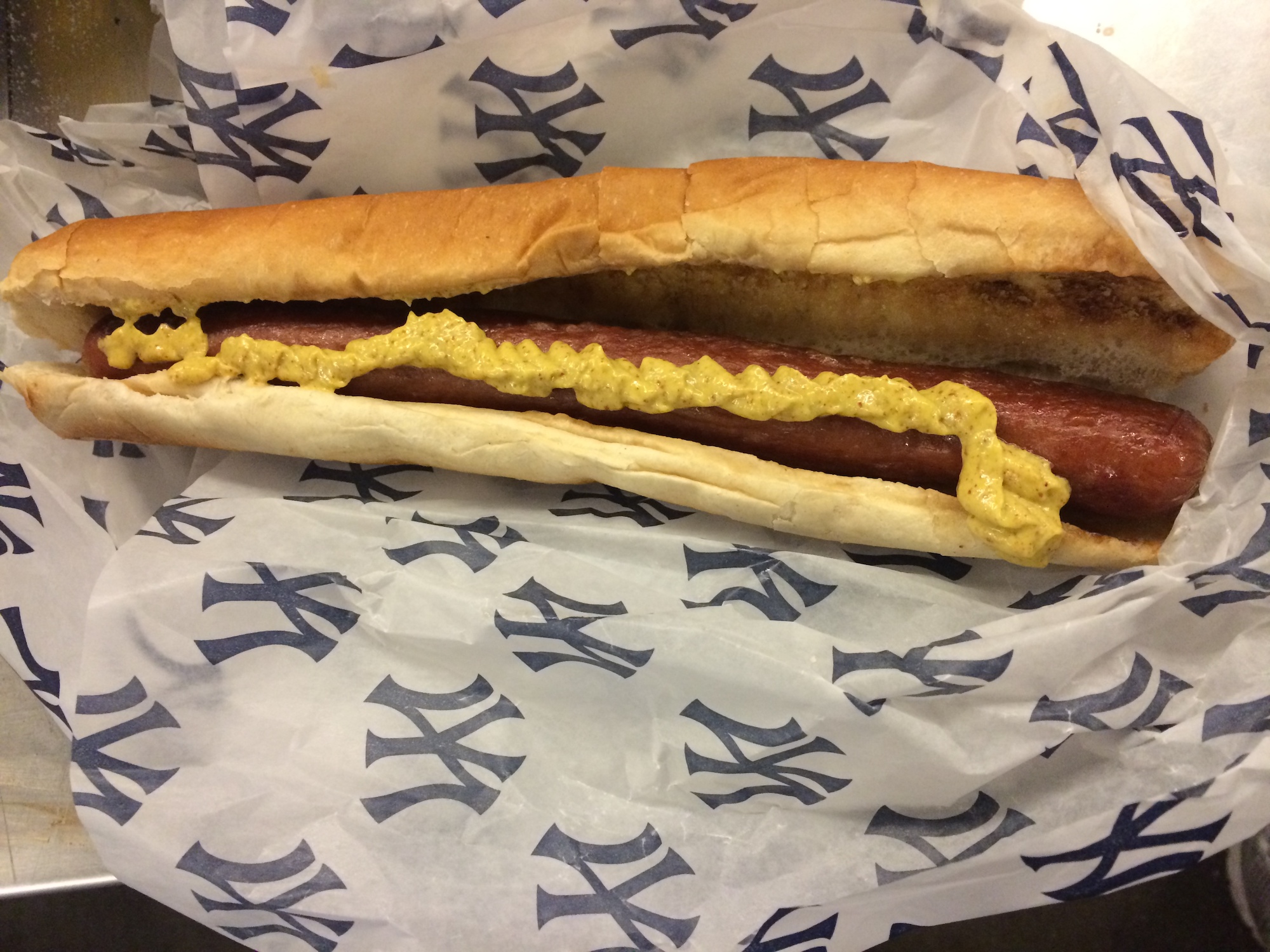

https://aviewfrommyseat.com/venue/Yankee+Stadium/seating-chart/baseball
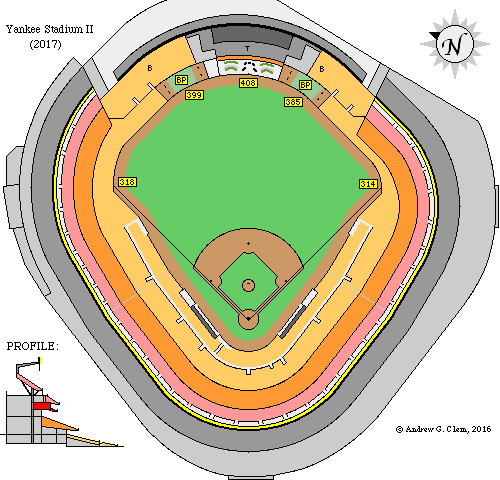
In the inaugural game on April 16, 2009, the home team lost to the Cleveland Indians, 10-2. The Yankees came back the next day and won, 6-5, as Derek Jeter and four other Yankees hit home runs. During the first two and a half months of the inaugural season, nearly twice as many home runs were hit in the New Yankee Stadium than in its predecessor last year. After a series of lame excuses from the Yankees front office, it became obvious to most people what anyone can see from the diagrams above - that the distance to right center field is at least 15 feet less than before.
When the first Yankee Stadium opened in 1923, it was the largest and most magnificent stadium in baseball and was home to many legendary players and teams. Due to its deteriorating condition in the late 1960s and early 1970s, Yankee Stadium was renovated and rebuilt between 1974 and 1976. In the 1990s and early 2000s nearly every team in baseball built a new ballpark. While many fans and traditionalists preferred the Yankees to remain at Yankee Stadium, the team wanted a new ballpark built in order to generate additional revenue and to offer fans more amenities and luxuries. After years of discussions and rumors, the New York Yankees officially announced plans for a new Yankee Stadium in June 2005. Constructed adjacent to the old Yankee Stadium, groundbreaking occurred on August 16, 2006.
The New Yankee Stadium:
A new era in the history of the Yankees began on April 16, 2009. The iconic facade and unique interior features of the original Yankee Stadium prior to its renovation in the 1970s were replicated in the new stadium.
The stadium consists of two separate structures. The exterior wall, consisting of limestone and granite, constructed to replicate the original Yankee Stadium facade, built in 1923, is known as the Great Hall.
It features 31,000 square feet and serves as the concourse before entering the stadium.
The interior stadium itself rises over the top of the exterior. From the outside, the structures appear as one building almost identical in materials and design to the original stadium.
Cavernous concourses give way to open spaces with sight lines to the field from nearly every vantage point in the stadium.
The signature copper frieze and the lattice work that once rimmed the original stadium roof and was recreated in the outfield of the renovated Yankee Stadium, is now replicated in its original location at the new Yankee Stadium.
Yankee Stadium seats approximately 52,000 fans as the main grandstand consists of four levels stretching from foul pole to foul pole, with nearly 30,000 seats in the first two levels. The third level contains 56 luxury suites and the fourth level features a split level upper deck. Fans who enjoyed sitting in the bleachers at the old Yankee Stadium can continue to do so at the new stadium as it has the same number of bleachers and includes a food court.
Monument park, located beyond the outfield fence in center field, honors members of past Yankee players with monuments, plaques and retired numbers. The stadium has the same dimensions and bullpen placements as the old Yankee Stadium. A 56ft. by 101ft. high-definition video scoreboard above the bleachers in center field. Hand operated auxiliary scoreboards are incorporated as part of the right-center and left-center fences.
https://www.ballparksofbaseball.com/ballparks/yankee-stadium
On February 6, 1921, the Yankees announced the purchase of 10 acres of property in the west Bronx. The land, purchased from the estate of William Waldorf Astor for $675,000, sat directly across the Harlem River from the Polo Grounds, where the Yankees' had played since 1913. On their newly acquired property, the Yankees would build the most famous ballpark in history.
As originally designed, Yankee Stadium was to feature three decks and a roof which completely encircled the playing field. However, ownership scaled back the plan such that the grandstand didn't quite extend to the foul poles. The left field grandstand was extended in 1928. In 1937, the right field grandstand was extended and concrete bleachers replaced the original wooden ones, bringing the stadium to its current configuration.
For forty years, Yankee Stadium was home to a steady stream of championship teams. Babe Ruth and Lou Gehrig passed on their legacy to Joe DiMaggio and Phil Rizzuto, who then passed it on to Yogi Berra, Mickey Mantle and Roger Maris. So mighty were the Yankees, and such a draw was the team and its stadium, that by 1958 the the Giants and Dodgers, New York's other Major League Baseball teams, had moved to California. For four years, from 1958 through 1961, there was only one place to go to watch Major League Baseball in New York City.
However, in the late sixties, an uncharacteristic drought of Yankee championships befell the team. Meanwhile, the expansion Mets where playing and winning championships in the new Shea Stadium in Flushing Meadow. By the early seventies, Yankee Stadium had become an old and obsolete stadium in a decaying neighborhood hosting a mediocre team.
Renovations were made in 1966 and 1967, but more than that was needed. In 1972, the team sold their stadium to the city and signed a thirty year lease. During the 1974 and 1975 seasons, the Yankees played at Shea Stadium while the city made major renovations to Yankee Stadium. The many steel columns which supported the roof and upper decks were removed, and the upper decks were cantilevered over the lower deck. The original roof and its famous copper facade were removed and replaced with a smaller, more modern roof. The facade was replicated above the new scoreboard which ran the entire length of the bleachers.
The renovated Yankee Stadium opened with much fanfare in 1976, and the Yankees wasted no time living up to their "new" stadium. The team appeared in the World Series in each of the next three years, winning the fall classic twice. Players like Reggie Jackson, Catfish Hunter and Ron Guidry picked up where Mantle and Berra left off a decade earlier. Except for brief period in the early 1990s, the Yankees have always fielded winning teams since their ballpark was renovated. In the late 1990s and 2000s, the Yankees have been the team to beat, appearing in six World Series while winning four of them. A cavalcade of stars, including Derek Jeter and Roger Clemens, have graced Yankee Stadium during these years.
On Sunday, September 21, 2008, Yankee Stadium closed its gates for good.
- On February 6, 1921, the New York Yankees announced the purchase of ten acres of property in the west Bronx
- The future home of Yankee Stadium was purchased from the estate of William Waldorf Astor for $675,000
- On April 18, 1923, "The House That Ruth Built" opened for business
- Yankee Stadium was a gigantic horseshoe shaped triple-decked ballpark that was the first to be called a stadium
- Countless articles have been written by countless historians bringing forth every aspect of the stadium's history
Harvey Frommer even once described its seat parts in great detail, "There were 10,712 upper-grandstand seats and 14,543 lower grandstand seats were fixed in place by 135,000 individual steel castings on which 400,000 pieces of maple lumber were fastened by more than a million screws."
- In the first Yankee Stadium (pre-1976) there were actually three center field monuments in fair territory:
- Lou Gehrig on the left
- Miller Huggins in the middle
- Babe Ruth on the right
https://www.baseball-almanac.com/stadium/yankee_stadium.shtml
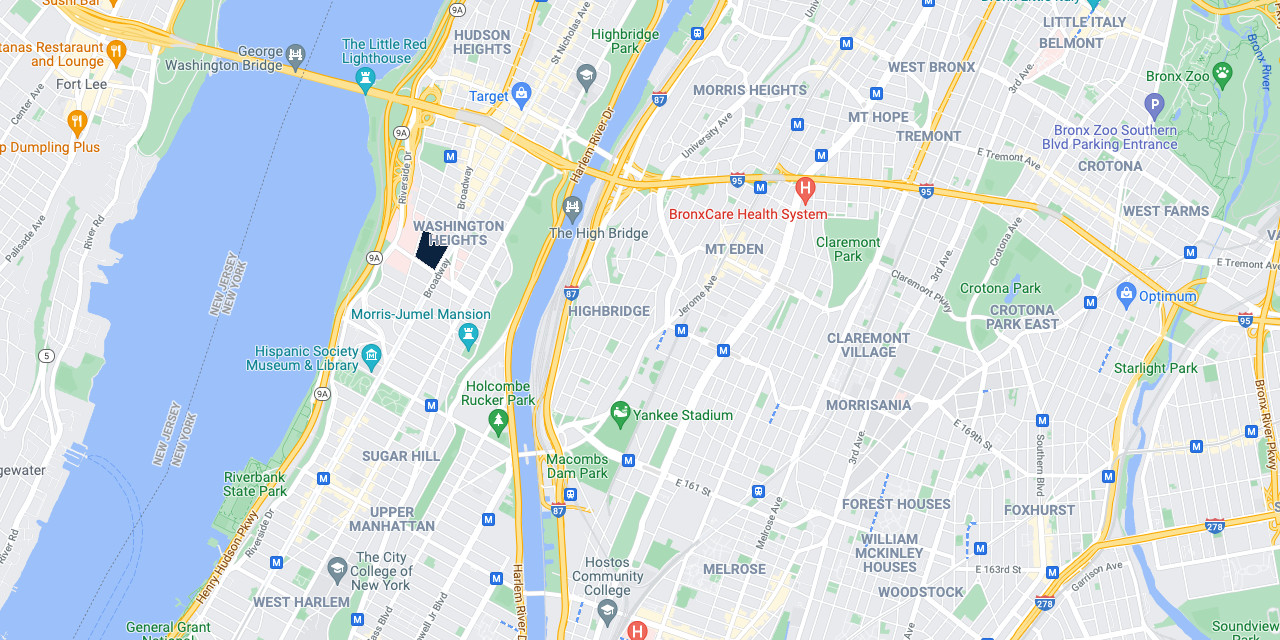
This was the home of the New York Yankees from 1903 to 1912, when they were known as the Highlanders.
Bounded by Broadway, 165th Street, Fort Washington Avenue, and 168th Street
https://www.google.com/maps/@40.8438908,-73.9540628,14z?hl=en
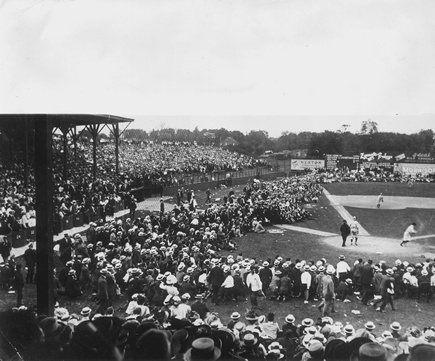
League rules allowed for standing room only fans to take up the foul lines and the outfield fences back then.
The ballpark's formal name, as painted on its exterior walls, was American League Park. Because the park was located on top of a ridge of Manhattan Island, it came to be known as Hilltop Park, and its team was most often called the New York Highlanders (as well as the Americans and the Yankees). This "Highland" connection contrasted with their intra-city rivals, the Giants, whose Polo Grounds was just a few blocks away, in the bottomland under Coogan's Bluff.
On June 30, 1908, Cy Young pitched a no-hitter against New York, winning handily 8-0. This was the third and final no-hitter in Young's illustrious career. The game coverage by The New York Times the following day, along with a summary of Young's career, is noteworthy in that the locals were referred to as the "New York Yankees" or "Yanks" throughout the article, demonstrating how common the nickname was by then, and with no reference at all to "Highlanders".
Both the park and the nickname "Highlanders" were abandoned when the American Leaguers left, at the beginning of the 1913 season, to rent the Polo Grounds from the Giants. The Polo Grounds had a far larger seating capacity, and by that time was made of concrete due to the 1911 fire. Hilltop Park was demolished in 1914.
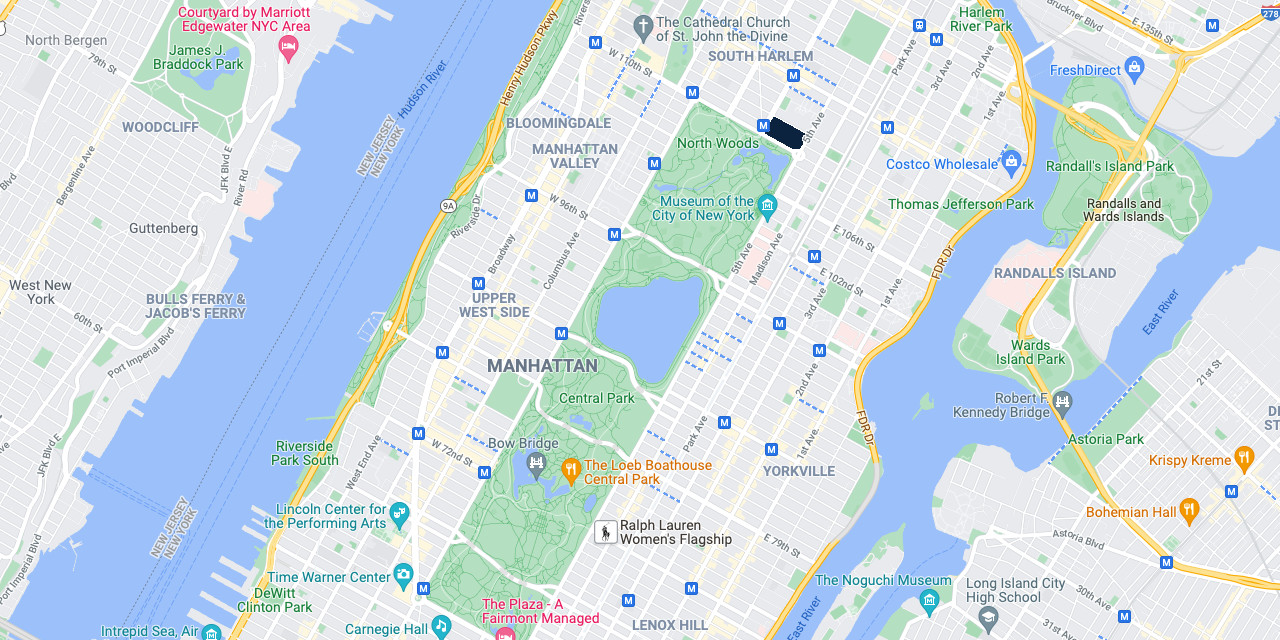
Opened in 1876 and demolished in 1889, was built for the sport of polo. Bound on the south and north by 110th and 112th Streets and on the east and west by Fifth and Sixth (Lenox) Avenues, just north of Central Park, it was converted to a baseball stadium when leased by the New York Metropolitans in 1880.
The original Polo Grounds was home to the New York Metropolitans from 1880 through 1885, and the New York Giants from 1883 through 1888.
https://www.google.com/maps/@40.7927741,-73.9576942,15z?hl=en

https://www.google.com/maps/@40.8094874,-73.9379345,13.75z?hl=en
Polo Grounds II:
New York City was in the process of extending its street grid into uptown Manhattan in 1889. Plans for an extended West 111th Street ran through the original Polo Grounds.
They relocated to the end of the Ninth Avenue elevated railway line at 155th Street and 8th Avenue (now Frederick Douglass Boulevard).
The Giants played in this second Polo Grounds for part of the 1889 season and all of the 1890 season until they finished building the stadium.
Polo Grounds III:
Home of the Giants.
Polo Grounds III was the stadium that made the name nationally famous. It was finished in 1890.
Polo Grounds III was known as Brotherhood Park when it opened in 1890.
In 1891 Polo Grounds II was sub-leased to the Manhattan Athletic Club and was referred to ever after as Manhattan Field.
Polo Grounds IV:
In 1911, a fire swept through the stadium's horseshoe-shaped grandstand, consuming wood and leaving only steel uprights in place. Giants decided to rebuild the Polo Grounds with concrete and steel,
The New York Yankees sublet the Polo Grounds from the Giants during 1913–1922 after their lease on Hilltop Park expired.
After the 1922 season, the Yankees built Yankee Stadium directly across the Harlem River from the Polo Grounds.
Babe Ruth's first home run as a Yankee (May 1, 1920) went over the right field grand stand into Manhattan Field. Modern research indicates the ball traveled about 500 feet in total, after clearing the Polo Grounds double decked right field stand.
Polo Grounds gets old:
- The stadium was not well maintained from the late 1940s onward; while the baseball Giants owned the stadium, the Coogan heirs still owned the parcel of land on which it stood.
- The neighborhood around the stadium had already begun to go to seed in the early 1950s.
- The stadium also had very little parking; its final form had opened two years after the Model T was introduced.
- Due to the manner in which the stadium was designed, fans had to actually pour onto the field to exit via the center field gates, which made for a problematic situation whenever attendance was anywhere near capacity.
- All of this combined to severely suppress ticket sales, even when the Giants played well.
Frustrated with the obsolescence and increasing dilapidation of the Polo Grounds, the Giants announced on August 19, 1957, that they would move following that season to San Francisco, California, following the Dodgers to the West Coast.
The Giants had won five World Series in the Polo Grounds.


